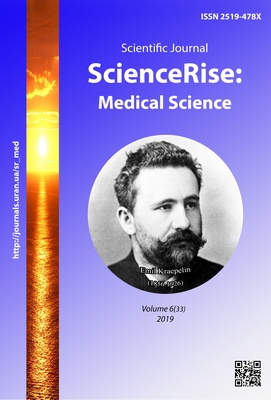Analysis of early patients outcomes after subarahnoid hemorhage depending of it`s complications
DOI:
https://doi.org/10.15587/2519-4798.2019.185670Keywords:
subarachnoid hemorhhage (SAH), aneurysm rapture, hydrocephalus, cerebral vasospasm, Glasgow Outcome Scale (GOS)Abstract
Aim. The purpose of our article was to analyze all cases of non-traumatic SAH that have been treated at our clinic since January 2013 to December 2016 and determine the impact of the complications that can affect on the early patient`s outcome.
Materials. Database included 127 patients with subarachnoid hemorrhage that were treated at the Regional Clinical Center for Neurosurgery and Neurology in Uzhgorod during 2013-2016. Extended analysis of the data was performed. The influence of various factors (intracerebral hematoma, symptomatic vasospasm, repeated rupture of aneurysm) on the early patient`s outcome was determined.
Result. It was found that more than a half of the patients (70 people) experienced certain types of complications and only 41.7 % of patients had no complications at all.
The most common complications were: intracerebral hematoma, intraventricular hemorrhage or their combination, as well as symptomatic vasospasm. According to our data, they were met with the same frequency of ~ 26-28 %. Rarely, occlusive hydrocephalus and re-rupture of the aneurysm occurred (7 % and 13 %). Mortality among patients with complications was 24 % - symptomatic vasospasm, 28 % - occlusive hydrocephalus, 17 % - intraventricular hemorrhage, 28 % - intracerebral hematoma, but in case of re-rupture of the aneurysm - up to 62.5 %. It is one of the most unfavourable factors for early outcome after SAH (p <0.001).
Conclusions. Thus, according to our data, the most unfavourable SAH complication for early outcome is symptomatic cerebral vasospasm and repeated rupture of the aneurysm, slightly less - occlusive hydrocephalus and parenchymal hemorrhage. No significant influence of the presence of intraventricular haemorhage on the initial computed tomography after SAH was found
References
- Larsen, C. C., Astrup, J. (2013). Rebleeding After Aneurysmal Subarachnoid Hemorrhage: A Literature Review. World Neurosurgery, 79 (2), 307–312. doi: http://doi.org/10.1016/j.wneu.2012.06.023
- Lord, A. S., Fernandez, L., Schmidt, J. M., Mayer, S. A., Claassen, J., Lee, K. et. al. (2011). Effect of rebleeding on the course and incidence of vasospasm after subarachnoid hemorrhage. Neurology, 78 (1), 31–37. doi: http://doi.org/10.1212/wnl.0b013e31823ed0a4
- An, S. J., Kim, T. J., Yoon, B.-W. (2017). Epidemiology, Risk Factors, and Clinical Features of Intracerebral Hemorrhage: An Update. Journal of Stroke, 19 (1), 3–10. doi: http://doi.org/10.5853/jos.2016.00864
- Lawton, M. T., Vates, G. E. (2017). Subarachnoid Hemorrhage. New England Journal of Medicine, 377 (3), 257–266. doi: http://doi.org/10.1056/nejmcp1605827
- Molyneux, A. J., Kerr, R. S., Yu, L.-M., Clarke, M., Sneade, M., Yarnold, J. A., Sandercock, P. (2005). International subarachnoid aneurysm trial (ISAT) of neurosurgical clipping versus endovascular coiling in 2143 patients with ruptured intracranial aneurysms: a randomised comparison of effects on survival, dependency, seizures, rebleeding, subgroups, and aneurysm occlusion. The Lancet, 366 (9488), 809–817. doi: http://doi.org/10.1016/s0140-6736(05)67214-5
- Koopman, I., Greving, J. P., van der Schaaf, I. C., van der Zwan, A., Rinkel, G. J., Vergouwen, M. D. (2018). Aneurysm characteristics and risk of rebleeding after subarachnoid haemorrhage. European Stroke Journal, 4 (2), 153–159. doi: http://doi.org/10.1177/2396987318803502
- Milinis, K., Thapar, A., O’Neill, K., Davies, A. H. (2017). History of Aneurysmal Spontaneous Subarachnoid Hemorrhage. Stroke, 48 (10), e280–e283. doi: http://doi.org/10.1161/strokeaha.117.017282
- Lindekleiv, H., Sandvei, M. S., Njolstad, I., Lochen, M.-L., Romundstad, P. R., Vatten, L. et. al. (2011). Sex differences in risk factors for aneurysmal subarachnoid hemorrhage: A cohort study. Neurology, 76 (7), 637–643. doi: http://doi.org/10.1212/wnl.0b013e31820c30d3
- Pegoli, M., Mandrekar, J., Rabinstein, A. A., Lanzino, G. (2015). Predictors of excellent functional outcome in aneurysmal subarachnoid hemorrhage. Journal of Neurosurgery, 122 (2), 414–418. doi: http://doi.org/10.3171/2014.10.jns14290
- Petridis, A. K., Kamp, M. A., Cornelius, J. F., Beez, T., Beseoglu, K., Turowski, B., Steiger, H.-J. (2017). Aneurysmal Subarachnoid Hemorrhage. Deutsches Aerzteblatt Online, 114 (13), 226–236. doi: http://doi.org/10.3238/arztebl.2017.0226
Downloads
Published
How to Cite
Issue
Section
License
Copyright (c) 2019 Eugenia Tsoma, Volodymyr Smolanka, Szergej Capec

This work is licensed under a Creative Commons Attribution 4.0 International License.
Our journal abides by the Creative Commons CC BY copyright rights and permissions for open access journals.
Authors, who are published in this journal, agree to the following conditions:
1. The authors reserve the right to authorship of the work and pass the first publication right of this work to the journal under the terms of a Creative Commons CC BY, which allows others to freely distribute the published research with the obligatory reference to the authors of the original work and the first publication of the work in this journal.
2. The authors have the right to conclude separate supplement agreements that relate to non-exclusive work distribution in the form in which it has been published by the journal (for example, to upload the work to the online storage of the journal or publish it as part of a monograph), provided that the reference to the first publication of the work in this journal is included.









